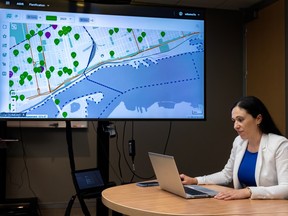AGIR allows Montreal city planners to co-ordinate work, plan projects years in advance and communicate with external partners.

Article content
When Line Dumont was a teenager, there were often seven people sharing one bathroom in her Ahuntsic home.
With two parents, two siblings, and girlfriends or boyfriends in the house, managing time became pivotal so household members could get to school and work on time.
Dumont’s father, an engineer, planned everyone’s wakeup times and assigned time in the bathroom.
Advertisement 2
Story continues below
Article content
“He got fed up one morning,” Dumont said. “He had an important meeting (for work), but someone was in the bathroom, so later on, he called a family meeting to co-ordinate everyone’s schedule.”
Now an engineer herself, Dumont says she gets her knack for planning from her father. As the Montreal’s section head for integrated planning, Dumont co-ordinates the work of 70 city departments, planning thousands of roadwork projects three to five years ahead of time.
The work requires co-ordinating teams of construction workers and city services like waterworks at thousands of sites every year. Roughly 74,000 permits are approved annually for any type of work on a street, from closing a road for a street festival to undertaking aqueduct and sewer replacement. All that comes to Dumont’s attention. She plans in concert with other entities that work on underground infrastructure, like Vidéotron or Hydro-Québec.
Her team was created in 2014 in response to citizens’ frustrations over the same stretches of streets being continually closed for construction. The remake of St-Laurent Blvd. in 2007 was a prime example, as crews of Énergir (then called Gaz Métro) returned the year after a year-long project was completed, closing the street again to connect 40 buildings to its natural gas network.
Article content
Advertisement 3
Story continues below
Article content
Until recently, Dumont’s team was keeping track of projects using 70 computerized spreadsheets that had to be manually updated any time there was a change to a project or a new permit was issued.
“It was all done through email and updated manually by the team — that was a huge administrative headache,” Dumont said.
Since 2022, the city has been using new software developed in-house to co-ordinate projects and streamline the process. Called Assistant gestion des interventions sur rue, or AGIR, the software is the first one to geolocalize worksites on a cloud-based program that gives access to all the the teams involved.
“The beauty of this tool is that we can go further in the planning than we did before,” Dumont said.
AGIR has a function that allows boroughs to standardize the permit-issuing process and manages communication with the central city for each permit.
Its planning function focuses on all the work required before a permit is issued to occupy public land. The program is still being developed, but already allows teams to search for worksites on a map and access pertinent information. The basic information for each worksite is shared with the general public in the city’s Info-Travaux map. That map allows citizens to know which entity is in charge of a work site (city of Montreal, STM, etc.), how long the work is supposed to last and what detours are in place.
Advertisement 4
Story continues below
Article content
Dumont and her team are able to see more detailed information down to the traffic detour plan and even the sizes of the traffic cones for each worksite. She says the software allows her team to triple its capacity to analyze and co-ordinate worksites, using the same workforce. Dumont’s team co-ordinated 1,416 interventions from city services on a roadway last year, and 889 this year.
“The software allows us to talk to a lot of people at the same time,” she said. “For example, with the water services team, they will plan out all their projects (on the software) and analyze them, and then plan out their needs, which sidewalks or which roads they will target. It’s then up to us to look at all the needs and see which ones are priorities, and which ones can be delayed, and how we can co-ordinate things so we don’t have to come back to the same space four separate times.”
Dumont then meets with the various city departments to iron out a firm schedule for all projects.
The software allows the city to identify sectors that will be under heavy pressure. In the city’s east end near Notre-Dame St., for example, lots of construction projects are delayed because of the impact of the long-term reconstruction of the Louis-Hippolyte-La Fontaine Tunnel.
Advertisement 5
Story continues below
Article content
Montrealers love to complain about how the city’s various roadwork projects are badly co-ordinated.
In early September, the city’s opposition asked the Plante administration to do a better job of managing work sites, saying the lack of organization is costing Montrealers too much time in congestion.
Dumont swears the situation has improved with the AGIR system, and she hopes Montrealers will notice a significant improvement in 2025, the second year that all the city’s roadwork projects have been planned with the new software. Most projects are planned at least three years ahead of time.
“Every year, we will be getting better, finding new ways to be more efficient and productive,” she said.
However, there will always be situations that the city can’t plan ahead of time, and there will always be areas of the city where there are more roadwork projects.
“There are always emergency works that we can’t control, or a need to connect a building that has to be done. We can’t stop services that are essential for citizens.”
Recommended from Editorial
Advertisement 6
Story continues below
Article content
Article content



Comments